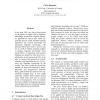Free Online Productivity Tools
i2Speak
i2Symbol
i2OCR
iTex2Img
iWeb2Print
iWeb2Shot
i2Type
iPdf2Split
iPdf2Merge
i2Bopomofo
i2Arabic
i2Style
i2Image
i2PDF
iLatex2Rtf
Sci2ools
NAACL
2007
2007
Unsupervised Natural Language Processing Using Graph Models
In the past, NLP has always been based on the explicit or implicit use of linguistic knowledge. In classical computer linguistic applications explicit rule based approaches prevail, while machine learning algorithms use implicit knowledge for generating linguistic knowledge. The question behind this work is: how far can we go in NLP without assuming explicit or implicit linguistic knowledge? How much efforts in annotation and resource building are needed for what level of sophistication in text processing? This work tries to answer the question by experimenting with algorithms that do not presume any linguistic knowledge in the system. The claim is that the knowledge needed can largely be acquired by knowledge-free and unsupervised methods. Here, graph models are employed for representing language data. A new graph clustering method finds related lexical units, which form word sets on various levels of homogeneity. This is exemplified and evaluated on language separation and unsupervi...
Computational Linguistics | Implicit Knowledge | Implicit Linguistic Knowledge | Linguistic Knowledge | NAACL 2007 |
Related Content
| Added | 30 Oct 2010 |
| Updated | 30 Oct 2010 |
| Type | Conference |
| Year | 2007 |
| Where | NAACL |
| Authors | Chris Biemann |
Comments (0)

